When most people hear Leadsled they think of a custom low riding car, well fishing has its own definition of Leadsled, we’re talking low riding crank baits trolled behind leadcore line, with some custom additions.
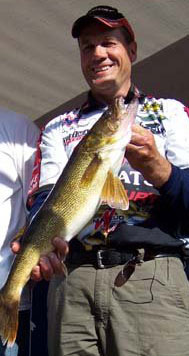
Trolling for me has become a huge factor in my fishing arsenal. At one time I was strictly a live bait rigger, and unless I had a hunk of meat on a hook I didn’t feel comfortable. Fishing various bodies of waters has forced me to learn other tactics including trolling and trolling with leadcore in particular. I would like to share with you some of the details that I have learned to help you shorten your learning curve. You can virtually troll any kind of crankbait on leadcore; stick baits, shad style baits, deep diving stick baits or shallow style baits. The biggest variable is trying to find out what lures will trigger the most bites. That can simply be a matter of running different lures and let the fish clue you into what they want.

Time of year, water temps, forage and depths at which the fish are holding are variables that can be determined using quality electronics. Units from Humminbird, in particular the “side imaging capable” 998SI and 1197SI units are my choice. The beauty of Side Imaging is you can scan out to the side of the boat to find fish! It’s almost like having a huge “visual trawler net” gathering in fish images. With additional features like Down Imaging and Switchfire, these types of units become a valuable tool in your fishing arsenal.
The other key components are your rod and reel choices. The rods I like are a 10’6” and a “shorty” in the 5’ length giving you a nice spread. I use the trolling rod made by Scheels; you want a rod with some give, not a buggy whip but a rod with some shock absorbency because lead core does not have any give to it. The reels I use are line-counter style and sized to take all 10 colors of leadcore line. When looking for a reel I look for the larger sizes. If you are not familiar with leadcore line, it’s a long thread of lead wire coated with a Dacron covering for strength. It comes in several weights, but 18# test is the most popular for walleye trolling because it has the smallest diameter-to-weight ratio of the available lines. The other component is the leader material. I prefer to use Berkley FireLine Crystal in 14# test, with a leader length of 20’. The reason I chose FireLine Crystal is because this line is also no-stretch and can telegraph back to the rod tip what the crank bait is doing, such as fouling with weeds or skipping across the bottom, helping me to find the perfect position when setting the lure.
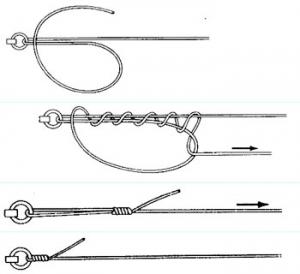
Uni KnotI prefer to connect the FireLine to the leadcore using a Uni Knot. With leadcore, you need to push the Dacron covering back about 8” and break off the inner lead wire, use this tag end of Dacron to tie the Uni Knot.
Now that you have the basic setup down, you need to get your boat setup. Holding on to one of these rods could get tiring trolling all day so using rod holders is a must. I run a Tuffy 1890 Osprey boat equipped with side rails which is nice, because you eliminate the need to drill extra holes in your nice boat to install rod holders. You are going to need a good, stout rod holder with some adjustability. I like the rod holders from Cannon. When you are trolling between the occasional snag and some of the vicious hits a big Walleye has, these holders are built tough and hold up well.
My main trolling propulsion is provided by a Mercury 9.9 Pro-Kicker. This engine is an ultra reliable workhorse. I can troll down to .8 or up to 3+ mph with a twist of the handle; it’s an ultra quiet and smooth running kicker. The built-in stow, deploy and centering straps on this motor are also a great feature.
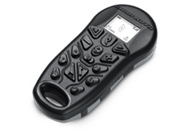
Minn Kota i-Pilot RemoteA powerful tool that I often use in conjunction with my kicker is my Terrova bowmount trolling motor by Minn Kota. I often deploy my Terrova to assist in tight contour trolling by bringing steering to the bow, helping to make those tight swings. Another bonus is the assistance of keeping you going the right direction with the Auto Pilot feature. When you are fighting that big fish, you can stay on track!
Another feature that has come out is the Minn Kota I Pilot. The I Pilot is awesome for contour trolling. The I Pilot is a GPS based guidance and control system, so you will be able to drop way points on a break line, then go back and troll that line with precision, all controlled with a handy remote.
Another thing you will need to learn to utilize are Off Shore Tackle Side Planer Boards. They are used to get a wider spread out of your presentation; keeping the lines away from the boat and the lures away from each other.
Now we’ve gotten you set up with a rod and reel and your boat rigged. Let’s talk about putting these Leadsled crankbaits in the water and start catching fish.
The first thing to keep in mind is the depth at which leadcore will bring your crank bait down to. Due to the larger diameter of the line, the depth is speed dependent; the faster you go, the higher your crank bait will run. Slow down and it runs deeper; speed up it rises up in the water column. You can let out more line to fine tune the depth at which your baits run. There is no consistent dive curve, after some time on the water you will get a feel for this. So what speeds do you run to start? I typically find myself in the 2.0 to 2.8 mph range, but here is where you need to let the fish tell you the speed that they prefer. One thing to keep in mind, it’s easy to let out too much line! The leadcore line itself will start dragging on the bottom, be sure to watch the rod tip for vibration, indicating that the crankbait is doing its “dance”.
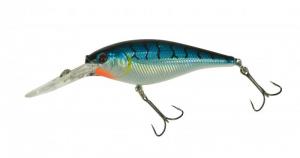
Berkley Flicker ShadMy “go to” crankbait is a Berkley Flicker Shad but any other style of crankbait can be used. If I have 4 lines out, I mix up colors, styles and sizes, such as running 5cm and 7cm Flicker Shads in various colors. Once again you need to let the fish tell you what they want for a meal, then you can begin fine-tuning the presentation.
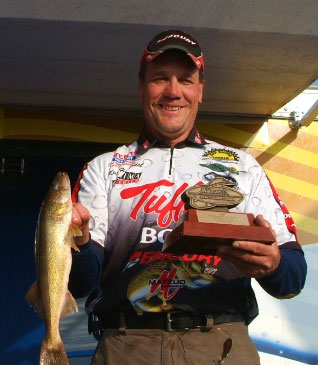
Make sure you check your drag. I run mine on the loose side due to the low stretch factor of the line. This helps to prevent hook tear outs. The shock absorbency of a good quality trolling rod like the ones I use from Scheels is critical.
Ok, so lines are out crank baits are doing their thing, FISH ON!!! You have the bowmount in the water keeping you on a steady course allowing you to focus on the fight. You don’t need to set the hook, I actually let them fight for a bit before I grab the rod out of the holder which helps drive the hooks in and tire them out. Grab the rod out the holder (no need to pump the rod) applying a steady and slow pace when reeling. If the fish wants to run let them, don’t horse them in, you WILL tear the hooks out!
And that’s how you can get your crankbaits down to where the fish are, using the Leadsled CrankBait trolling method. This method helped me to win the 2009 FLW Walleye League Championship and I’m sure these tips will help you too!










